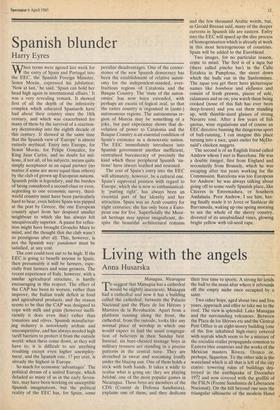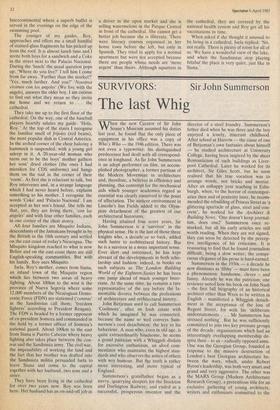Living with the angels
Anna Husarska
Managua, Nicaragua
To suggest that Managua has a cathedral would be slightly inaccurate. Managua had a cathedral and now it has a building called the cathedral, between the Palacio Nacional and the Plaza de los Heroes y Martires de la Revolucidn. Apart from a platform running along the front, the cathedral, from the outside, looks like any normal place of worship in which one would expect to find the usual congrega- tion of believers in their Sunday best. Instead, six bare-chested teenage boys in military trousers are standing in a precise patterns in the central nave. They are drenched in sweat and screaming loudly under the blazing sun. One of them holds a stick with both hands. It takes a while to realise what is going on: they are playing beisbal, one of the most popular games in Nicaragua. These boys are members of the CDS (Comite de Defensa Sandinista), explains one of them, and they dedicate
their free time to sports. A strong hit sends the ball to the main altar where it rebounds off the empty niche once occupied by a saint.
Two other boys, aged about two and five years, approach and offer to take me to the roof. The view is splendid: Lake Managua and the surrounding volcanoes. Between the Plaza de los Heroes etc and the Central Post Office is an eight-storey building (one of the few inhabited high-rises) covered with murals which seem to be a mixture of the socialist-realist propaganda common to Eastern bloc countries and the works of the Mexican masters Rivera, Orozco or, perhaps, Sjqueiros. To the other side is the wasteland which is all that is left of the city centre: towering ruins of buildings des- troyed in the earthquake of December 1972 and now covered with the graffiti of the FSLN (Frente Sandinista de Liberaci6n Nacional). On the hill beyond one sees the triangular silhouette of the modern Hotel Intercontinental where a superb buffet is served in the evenings on the edge of the swimming pool.
The younger of my guides, Roy, approaches and Offers me a small handful of stained-glass fragments he has picked up from the roof. It is almost lunch time and I invite both boys for a sandwich and a Coke in the street next to the Palacio Nacional.
During the 'lunch' the usual question pops up: 'Where do you live?' I tell him I come from far away. 'Farther than the market?'
`Yes, much farther. And you?' Nosotros vivimos con los angeles' (We live with the angels), answers the older boy. I am curious to find out what they mean so they invite
me home and we return to . . . the cathedral.
They take me up to the first floor of the cathedral. On the way, one of the baseball players heartily salutes my guide: 'Hola, Roy.' At the top of the stairs I recognise the familiar smell of frijoles (red beans), the most popular dish in Central America. In the arched corner of the choir balcony a hammock is suspended, with a young girl asleep in it. A 20-year-old woman who turns out to be the boys' mother gathers her sons' dried clothes (the ones I had mistaken for CDS uniforms) and hangs them on the nail in the corner of their 'room'. At first she is reluctant to talk, but Roy intervenes and, in a strange language which I had never heard before, explains something to his mother. I recognise the words 'Coke' and 'Palacio Nacional'. I am accepted as her son's friend. She tells me that, yes, they are living there, 'con los angeles' and with four other families, each in one corner of the choir storey.
All four families are Misquito Indians, descendants of the Jamaicans brought in by the British in the 18th century and settled on the east coast of today's Nicaragua. The Misquito kingdom reached to what is now Belize and on the east coast there are still English-speaking communities. But with his family, Roy uses Misquito.
Isela, Roy's mother, comes from Siuna, an inland town of the Misquito region which lies between two- areas of heavy fighting. About 100km to the west is the province of Nueva Segovia where some 12,000 members of the Nicaraguan Demo- cratic Force (FDN) are stationed (`contras' as the Sandinistas call them; 'freedom fighters' according to President Reagan). The FDN is headed by a former opponent of ex-president Somoza and commanded in the field by a former officer of Somoza's national guard. About 100km to the east from Siuna is Puerto Cabezas where heavy fighting also takes place between the con- tras and the Sandinista army. The civil war, the impossibility of working the land and
the fact that her brother was drafted into the Sandinista militia persuaded Isela to leave Siuna and come to the capital together with her husband, two sons and a sister.
They have been living in the cathedral for over two years now. Roy was born here. Her husband has an on-and-off job as a driver in the open market and she is selling watermelons in the Parque Central in front of the cathedral. She cannot get a better job because she is illiterate. There were literacy courses organised in her home town before she left, but only in Spanish. They tried to apply for a normal apartment but were not accepted because there are people whose needs are 'more urgent' than theirs. Although squatters in the cathedral, they are covered by the national health system and Roy got all his vaccinations in time.
When asked if she thought it unusual to be living in a cathedral, Isela replied: `No, not really. There is plenty of room for all of us. We have a wonderful view of the lake, and when the Sandinistas stop playing beisbal the place is very quiet, just like in Siuna.'











































 Previous page
Previous page